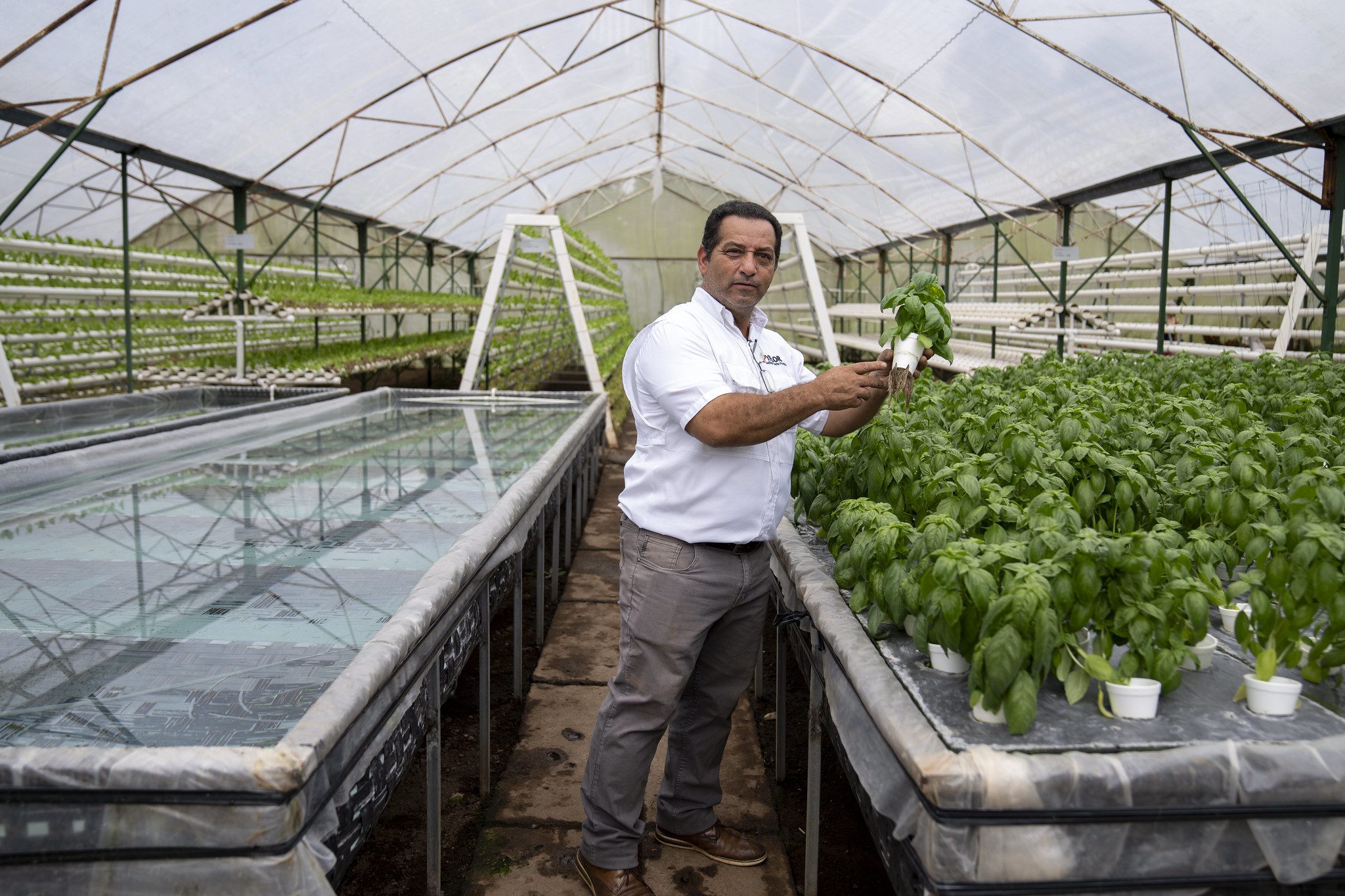A dust devil whips down the dirt road behind a line of people huddling under umbrellas to shield themselves from blistering sun. In El Amatillo, an informal neighborhood on the outskirts of Honduras’ capital, Tegucigalpa, locals must bear these arid, hot conditions for months during the dry season.
A much-needed bounty has arrived today: staff from Banco de Alimentos Honduras (BAH), the Honduran Food Bank, unload hundreds of crates of fresh vegetables onto the side of the road. Nearly spilling out of the crates are more than a thousand heads of lettuce, picked the day before through BAH’s agricultural recovery program, through which they harvest surplus produce from farms around the country.
“We never see vegetables like this up here,” says Diana Banegas, a local with a crate in her hands who is helping coordinate the deliveries. “I basically never buy vegetables. They’re too expensive, and I have to ride buses for two hours to get to the market from here.”
Between the high rates of poverty and the distance from grocery stores and produce markets, El Amatillo is a food desert.
“We’re targeting communities like El Amatillo, where many families live on less than a dollar a day and have neither the access nor the economic resources to get the basics of the food pyramid, much less a balanced, nutritious diet,” says Vanessa Caballero, executive director of BAH.
Across Honduras, 19 percent of people are undernourished. BAH’s Kilometers of Nutrition program has honed in on 20 communities around the country with major food security challenges.
As part of the program, the food bank is delivering food baskets to 139 families in El Amatillo today. Each family is getting about 27 kilograms of food, the majority of it fresh fruits and vegetables including sweet potatoes, carrots, bananas, cucumbers, apples, and tomatoes. They also deliver 1,000 kilograms of food per week to schools in these areas to ensure students have complete meals around their studies.
“Before, our children rarely knew the pleasure of eating an apple or an orange,” says Sandra Flores Diaz, a mother of four and the community leader organizing the deliveries from BAH. “But now they do,” she smiles.
Another mother from the community, 44-year-old Lorena Cruz, tells Flores Diaz that today’s delivery is “a blessing.”

World Food Day, on October 16, is an important opportunity to acknowledge that El Amatillo is far from alone: more than 2 billion people on Earth can’t afford a healthy diet. Creating food systems that nourish everyone is an urgent concern all over the world. The day is also an opportunity to recognize how Bancos de Alimentos Honduras — and food banks all over the world — do so much more than deliver food.
“Early on in the Kilometers of Nutrition program, we were reaching people in vulnerable situations but we realized they sometimes weren’t accustomed to preparing the wide variety of fruits and vegetables we deliver,” says Velquiz Garcia, nutrition officer at BAH.
So as the day’s deliveries wrapped up, Garcia carried a crate of fresh produce down to Flores Diaz’s home. Around 20 people, mostly mothers surrounded by young children, gathered near a wood-burning stovetop. It was time for the monthly cooking and nutrition class that accompanies food deliveries.
“Today, we’re going to be using cucumbers and sweet potatoes, two of the vegetables in your baskets, in ways you may have not seen before,” Garcia tells the group. “So grab a knife, find a chopping board, and let’s get cooking.”
Garcia splits everyone into small groups to peel and dice. (“And save all the peels,” she reminds them. “If you have a cow or chickens, they’ll love eating this. Nothing needs to go to waste.”)
Garcia extols the nutritional value of sweet potatoes: low in glucose, high in fiber, lots of antioxidants, full of vitamins and minerals. She does the same for cucumbers while she tosses diced sweet potatoes into boiling water.
A few minutes later, one portion of boiled sweet potato gets puréed in a blender and then is poured into corn flour. A few eyebrows raise. Sweet potatoes in tortilla masa?
“These are sweet potato fortified tortillas,” says Garcia. “How many tortillas do your kids eat with each meal?”
“Three!” a mother shouts. “A dozen!” calls another. “I can’t keep count!” another mother laughs.
“We eat tortillas with every meal, and now each one can have a bit more nutrition,” says Garcia.
With the ease only years of practice can provide, Flores Diaz rolls the tortilla dough into a small ball and quickly flattens it in a wooden tortillas press. She delicately tosses it onto the smoking stovetop. Her neighbor Maria Suyapa Montalvan stands over the stove and deftly flips the tortillas by hand until they are pocked with brown spots. A stack of steaming tortillas grows.
“Learning to make these fortified sweet potato tortillas is a joy for me,” says Flores Diaz with a big smile. “I didn’t know how to do this before, but I now I can make them for my children.”

Kids gather round and Flores Diaz starts handing out tortillas with a spoonful of Honduran sour cream inside. Suyapa Montalvan takes a break from the stove, wipes sweat from her brow, and tries one.
Garcia looks at her expectantly.
“I wasn’t so sure about these,” she tells Garcia. “But I will be making these at home tonight.”
“I told you!” Garcia laughs.
The group settles down to snack on the tortillas, as well as a milky sweet potato pozol drink and cucumbers filled with a ricotta-like cheese. In a neighborhood with no church or community center, these monthly cooking classes with BAH are rare opportunities for neighbors from El Amatillo to come together.
“I love being around these mothers in their community,” says Garcia. “It fills my heart.”
Around the world, food banks like Banco de Alimentos Honduras aren’t just filling stomachs. They’re showing the kind of joy, nourishment, and community good food can provide.


